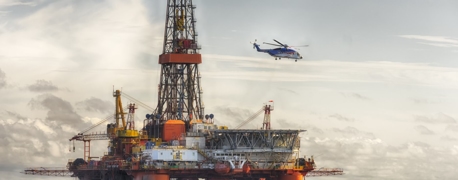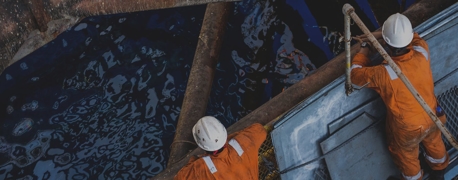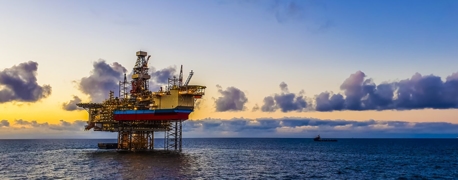Offshore Workers: 5 Reasons Why Rig Life Is More Dangerous in Winter

Working offshore is dangerous in any season, but winter presents specific challenges. Lower temperatures, heavy weather, and rough seas can bring significant risks to a rig and all its crew members, from deckhands to engineers to the captain of the vessel. Understanding these–and what can be done to stay safe–can help offshore workers avoid harm when temperatures drop.
Here are five main reasons rig life is more dangerous in the winter:
1. Increased Chance of Cold Stress
When it is cold outside, offshore workers have a higher chance of experiencing cold stress. The Occupational Safety and Health Administration (OSHA) defines cold stress as injuries that occur when the body loses too much heat. Factors like wind chill and dampness, caused by weather, ocean water, or even sweat can cause the body to lose heat faster and in higher temperatures. Cold stress can occur even when temperatures are around 60 degrees Fahrenheit, depending on wind chill and dampness.
Types of cold stress include:
- Frostbite occurs when the extremities, such as the fingers, toes, nose, or earlobes, freeze from exposure to extreme cold. Offshore workers could experience frostbite from cold temperatures at sea, from water exposure, or from direct contact with frozen equipment or freezing metals. In very minor cases of frostbite, called frostnip, there is no permanent damage. In more serious cases, the skin and underlying tissue will die. Severe frostbite may require amputation of the affected body parts.
- Trench foot is caused by exposure to cold temperatures and damp conditions. Also called immersion foot, this condition occurs when the feet are exposed for long periods of time. When feet are wet, they lose heat about 25 times faster than when they are dry. Trench foot can occur in temperatures as high as 60 degrees Fahrenheit. It can be extremely painful, but it is treatable. If untreated, serious complications like ulcers, gangrene, and nerve damage can occur. Trench foot got its name during World War I when soldiers did not take measures to keep their feet warm and dry. An estimated 2,000 American soldiers and 75,000 British soldiers lost their lives because of trench foot during the war.
- Chilblains are another type of cold stress that offshore workers may face. Caused by the inflammation of small blood vessels in the hands and feet, chilblains are characterized by red patches, swelling, and blisters on the affected areas. They are treatable, but if they are left untreated and persist, they can lead to infection.
- Hypothermia occurs when one’s body temperature drops too low from exposure to the cold. Offshore workers may experience hypothermia if they fall overboard into cold water or are exposed to freezing or near-freezing temperatures outside. Normal body temperature is about 98.6 degrees Fahrenheit, and when the body is exposed to the cold for too long, it will lose heat faster than it can produce it. Once the body temperature drops low enough (below 95 degrees Fahrenheit) the organs cannot function properly and will begin to shut down. Hypothermia will lead to heart failure, respiratory system failure, and death if untreated.
Cold stress injuries can be prevented in several ways. First, OSHA recommends that employers should train workers on the signs of cold stress and what to do if they or a fellow crew member begins experiencing these. Employers should also provide appropriate heating devices to make indoor and outdoor spaces safer for workers. They should limit the amount of time crew members spend on deck, exposed to the elements. They must also provide appropriate cold-weather gear and personal protective equipment (PPE) to workers depending on their job duties and whether they are exposed to cold temperatures and wet conditions.
2. Rough Seas & Heavy Weather
A unique challenge of working on an offshore oil rig is the rough seas and heavy weather brought on by winter—even in the Gulf. While the Gulf coast is known for a temperate climate, cold fronts at sea can create rough waters, which leads to a host of serious hazards. And that’s often even less rough than the Pacific or Atlantic oceans.
Here’s a closer look at some of these hazards:
- Severe seasickness: Winter often brings prolonged periods of rough seas, leading to severe seasickness among offshore workers. Even seasoned seamen can suffer from chronic nausea and vomiting in such conditions, impacting their ability to perform duties effectively. This not only affects individual health but can also compromise overall safety on the rig. Providing access to appropriate medical care and facilities, including sick bays staffed with trained medical personnel, is crucial to manage these conditions effectively.
- Heightened risk of helicopter incidents: Winter storms degrades the safety and reliability of helicopter transportation, a key mode of transport for offshore workers. Poor visibility, high winds, and turbulent seas can make flying dangerous, leading to delays, cancellations, or crashes. This not only affects the rotation of crews but also hampers the timely evacuation and emergency response in critical situations. Employers must ensure rigorous weather monitoring and have contingency plans for transportation disruptions.
- Increased risk of falling: The movement of a rig in rough seas greatly increases the risk of slip-and-fall accidents. These accidents can lead to serious injuries, including fractures or even overboard incidents. It is imperative that all walking surfaces on the rig are fitted with slip-resistant materials, and workers are equipped with appropriate non-slip footwear. Regular maintenance to remove ice and snow, along with safety training tailored to these conditions, can further reduce the risk of such accidents.
While offshore companies cannot control the weather, they can implement measures to mitigate its impact. This includes enhanced weather monitoring, comprehensive evacuation plans, installation of slip-resistant materials, and provision of adequate medical facilities. Such precautions are vital for safeguarding the health and safety of offshore workers during the challenging winter months.
3. Cold Shock, Hypothermia & Drowning
Falls overboard are dangerous in any weather, but during the winter they are even more so. Water that is 59 degrees Fahrenheit or colder will present a risk of cold shock to any offshore worker who falls overboard. Cold shock causes the heart rate to increase dramatically, the blood pressure to rise, and a person to gasp and breathe quickly. It can seem impossible to swim, and the chances of inhaling water are high. Even a skilled swimmer can drown if they do not know how to deal with cold shock.
If an offshore worker falls overboard and gets past cold shock, the danger isn’t over. Cold water can cause the nerves and muscles in the arms and legs to gradually shut down, which can make it difficult to stay afloat after about 10 minutes. If they’ve been in the water for 20 to 30 minutes, hypothermia will start setting in. Even holding onto a floatation device may become impossible.
Every offshore rig should have clearly defined plans and appropriate equipment in place to address man-overboard (MOB) incidents. Crew members must be properly trained on what to do to alert others and how to render aid. Fast action must be taken to save anyone who falls overboard.
4. Equipment Malfunction & Frozen Piping
Winter weather can affect offshore rigs in various ways. Cold temperatures can affect sensors and instrumentation, giving faulty readings to rig operators. Water or other materials inside uninsulated piping can freeze and expand, causing leaks or cracks. Equipment failure can be caused by extreme cold or significant increases and decreases in outside temperatures. All of these things can cause catastrophic events like fires, leaks, blowouts, or explosions.
Dropping temperatures on an oil rig means higher likelihood of ice accumulation. Ice buildup presents serious dangers to offshore workers in multiple ways, from increased accident risk to a higher likelihood that safety equipment fails.
The effects of ice buildup include:
- Slip and Fall Hazards: Ice buildup on walkways, platforms, and stairs creates a major slip hazard for workers. Such surfaces become extremely slick, making it easy for workers to lose their footing. Falls in such environments can lead to serious injuries, including fractures, head trauma, or even fatal incidents, especially if a worker falls from a significant height or into the sea.
- Impaired Functionality of Drilling Equipment: Ice can also accumulate on drilling equipment, potentially impairing its functionality. For example, moving parts can become encased in ice, leading to equipment seizing up or operating unpredictably. This not only disrupts drilling operations but can also lead to mechanical failures that might cause accidents, including uncontrolled releases of oil or gas.
- Compromised Safety Devices: Safety devices and emergency equipment, such as lifeboats, fire extinguishers, and emergency shut-off valves, are crucial in crisis situations. If these devices are encased in ice, they may not function properly when needed most. For instance, a frozen shut-off valve could prevent the crew from stopping an uncontrolled release of oil or gas, exacerbating the severity of an incident.
- Obstructed Visibility: Ice can form on windows and observation areas, obstructing visibility. This is particularly hazardous during operations that require precision and clear line of sight, such as crane operations or maneuvering supply vessels.
When offshore rigs operate in cold weather, they need to be prepared for low temperatures. The process of preparing a rig for winter is called winterizing, and it may involve a number of steps to protect pipes from freezing, instrumentation from failing, and equipment from malfunctioning in the cold. Offshore workers may face serious risks if rigs are not properly winterized or if they are not trained and educated on how to deal with potential equipment or piping problems caused by cold weather.
5. The Psychological Impact of Cold Weather
Winter can cause more than physical injuries. Cold weather and fewer daylight hours, plus days spent offshore in rough seas, can have a psychological impact on crews. Stress, fatigue, and depression have been linked to working in low temperatures and heavy weather.
Exercise, proper nutrition, and sleep can all improve the psychological impact of working in cold weather. Improved work schedules and a mental health support system for offshore crews can also help. Offshore employers must be mindful of all potential effects of working in inclement weather.
January: The Coldest Winter Month for Offshore Workers in the Gulf
The Gulf of Mexico contains the highest concentration of offshore oil rigs on the planet. Since 1942, approximately 6,000 structures have been installed. About 3,500 oil and gas structures remain; more than 3,200 of these are active today. The majority are located off the coast of Louisiana, followed by Texas, Alabama, and Mississippi.
The crews that operate these rigs face harsh conditions throughout the year. While the Atlantic hurricane season, which lasts from June 1 through November 30, presents significant weather-related dangers, temperatures in the Gulf of Mexico are typically the lowest in January. The water temperature in the Gulf of Mexico is also the lowest in January, ranging between 56°F to 67°F near U.S. shores.
Air and ocean temperatures, plus wind and rain, can have a tremendous impact on offshore workers in the Gulf of Mexico and across the planet. These hazards are not new, however. We know winter storms will come. We know that temperatures will drop and that offshore crews will face increased risks of cold stress injuries in January and all winter months.
Offshore Companies Must Protect Rig Workers from Winter Weather
The burden ultimately lies on offshore companies to take the right steps to protect workers from the dangers of rig life in the winter. This includes properly winterizing rigs, evacuating crews or altering course to avoid serious storms, shortening outdoor shifts, providing the right cold-weather gear, and offering nutritious food and plenty of water to avoid malnutrition and dehydration. Every winter weather hazard can be prevented when companies take proper care.
- Categories


